Behind the Scenes: Stokely: The Unfinished Revolution
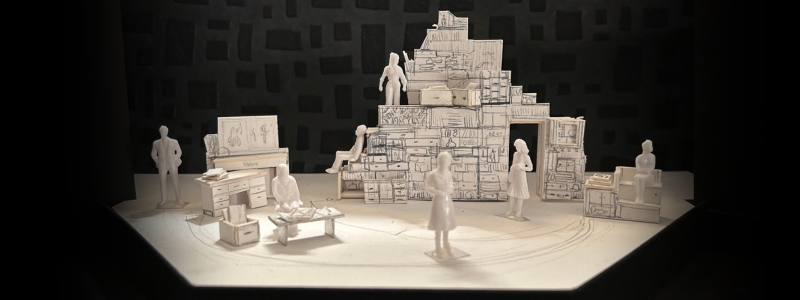
Stokely: The Unfinished Revolution – a world premiere from Nambi E. Kelley, directed by Tasia A. Jones – is rooted in both history and artistry. The characters onstage are dramatic interpretations of real leaders of the civil rights movement, and yet the set is abstract; it represents different years, various places, and – at times – the very nature of memory itself.
Scenic Designer Yeaji Kim and Costume Designer Gregory Graham discuss this delicate balance and shed light on their creative process, revealing the challenges and opportunities that arise when designing a new work based in lived history.
Scenic Design
Yeaji: What we see on stage is a collection of living objects. Throughout the play, we retrace different parts of Stokely Carmichael’s/Kwame Ture’s memory and meet influential characters who shaped him as a full person, so – for this design – I focused on how these memories exist in the space and how the space connects different times and places to these characters.
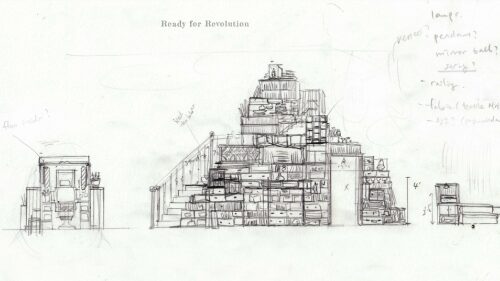
In the play, Stokely/Kwame is searching, archiving, gathering, and organizing his records and papers to build an institute. I wanted the set to feel like a jungle gym, or ‘a tower of the mind’ full of living objects; a tower that could also incorporate architectural elements, like a doorway and stairs, to allow characters to utilize different levels and points of access to the stage. The set is a sort of utility set; we used drawers that could actually be pulled out, shelves full of objects, and the set unit could be moved or fully flipped around to reveal different scenes. This simple-looking tower, in fact, had a lot of mechanisms to house all the drawers, shelves, the door, and the stairs, and there are also a few surprises built in that involve historic photos and documents.
For the photos, we wanted to have the real figures in the space with characters, performers, and the audience. For the documents, we used articles that were related to Stokely Carmichael and the civil rights movement from that time in history. Our Props Manager, Lara Musard, beautifully put those together, and thanks to our technical director Luke Lemanski and his team, a dream has been realized. You’ll have to see the show to know what I’m talking about!
All of these elements establish the tower as a symbol for legacy, which was important to me. The ideas of legacy and power were two of my inspirations. What is the legacy that is left to us, what do we want to leave behind, and what we can build from that? And how can the space connect the past, present, and future as Stokely revisits his memories and shares them with his mother?
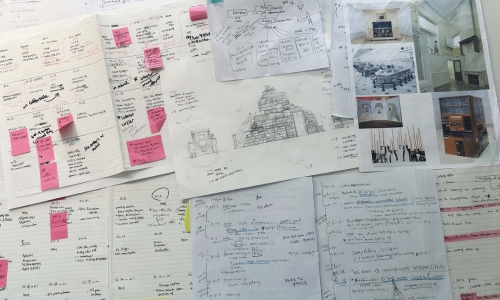
Creating new work is an exciting place to be. You may have a different draft of the play after you’ve already turned in the design. For example, we were still in the process of developing the story when I designed the set. At that time we had two acts with an intermission, and now the play is 90 minutes with no intermission, which I liked for the story. This also means that we had to embrace the fact that the script may radically change. So, to me, scenically, creating a malleable space was important, just in case a new draft required changes in the set. Luckily, we were able to use the set how we planned and I appreciated the time our team invested; everyone worked really hard until the end.
That I get to be part of the first team of artists to visualize this story – without any prejudice on the play nor reference or expectation (although there is always a certain degree of expectation when people come to see a show!) – is a privilege.
Costume Design
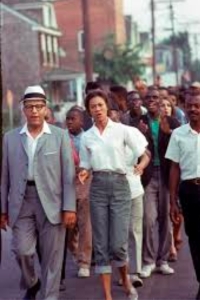
Gregory: The costumes for this production are based in realism. Each character in the play was a real person, so I was able to find pictures and then analyze the photos to decide what gesture would work to represent them.
For Malcolm X, it’s a black tie and black rimmed glasses; for Diane Nash it’s an a-line skirt. My favorite is Gloria Richards. I found this great image of her at a protest while wearing cuffed jeans and a short sleeve oxford shirt. This felt like an image that we don’t get to see often.
Because the actors play so many different characters, the costumes had to be solid, but also flexible; everyone needed to be able to maintain their primary character but morph into various other roles. The costumes for Stokely’s character, for example, are really about a base look, that then – with an added layer – transports the actor to a South Africa with his love, Miriam Makeba, and then – with a simple shirt change – we see Stokely giving his famous Black Power speech.
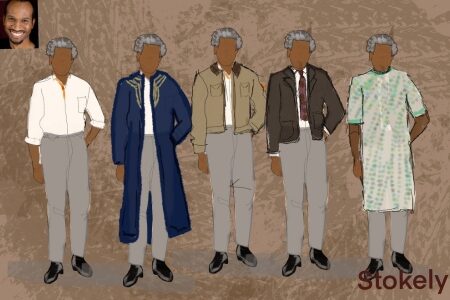
The actors that play Grandmother Cecilia, Tante Eliane, and Adolphus are dressed in vintage silhouettes that allows them to feel grounded in the past, whereas May Charles and Stokely are in silhouettes that feel more modern. The color palette is in conversation with the scenic elements so that the actors stand out while also blending in. Additionally, I chose to use mostly natural fibers, like linen, to help give a light and tropical feel to the characters, given that Stokely Carmichael emigrated from Trinidad.
World premieres are always a fun and challenging project. In our case, the script was in progress until shortly before to production began – as it often is with new work – so there was always a risk that characters or elements could be added or cut. On the other hand, this production is entirely new, so therefore there are no expectations and no preconceived ideas of how it should look – I get to be the first designer to decide how our Stokely Carmichael is presented to the world. That’s special.
Stokely: The Unfinished Revolution runs from May 24 – June 16, 2024. Tickets are available online or by calling the Box Office at (773) 753-4472.